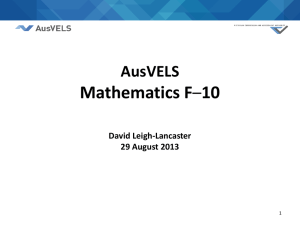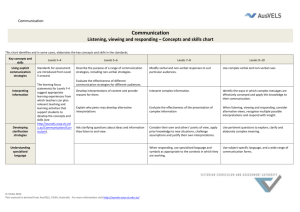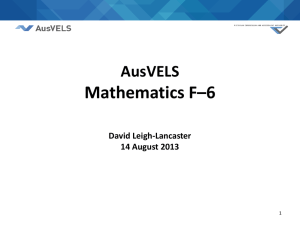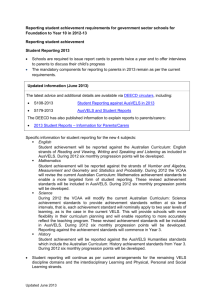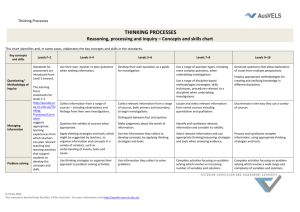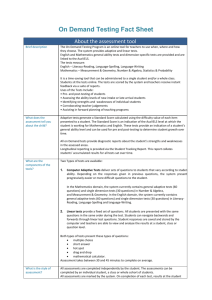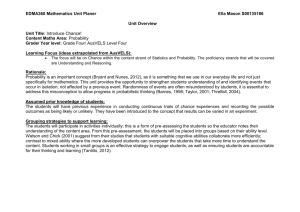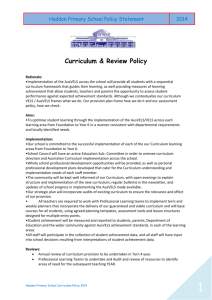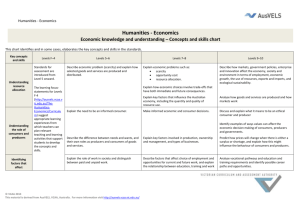AusVELS Mathematics: F to 10 - Victorian Curriculum and
advertisement
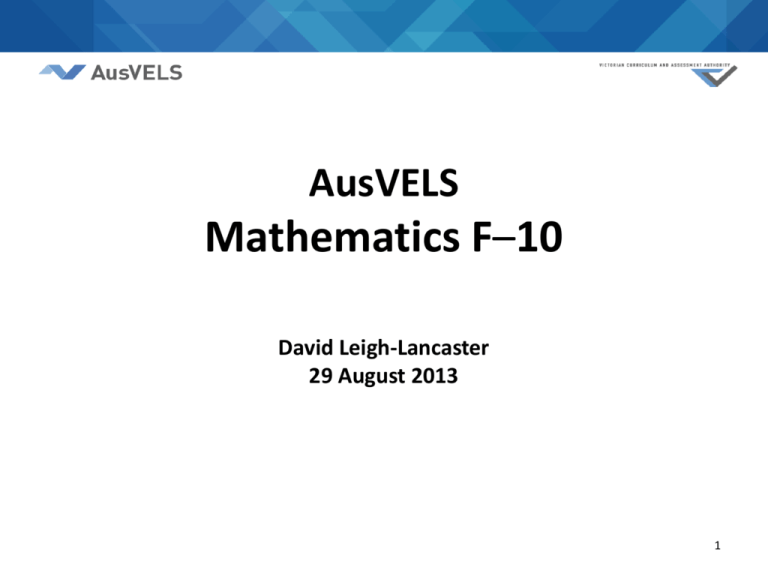
AusVELS Mathematics F–10 David Leigh-Lancaster 29 August 2013 1 Structure of the session 1. Elaborations 2. Curriculum sequence 3. Q and A 2 Elaborations (1) 1. Not mandatory 2. Accessed from AusVELS website via View E 3 Elaborations (2) Level 4 Content Descriptions Number and Algebra Number and place value Recall multiplication facts up to 10 × 10 and related division facts (ACMNA075) Elaboration using known multiplication facts to calculate related division facts 4 Elaborations (3) – can supplement From the VELS Level 3 http://pandora.nla.gov.au/pan/129125/201212060015/vels.vcaa.vic.edu.au/maths/index.html •They devise and use written methods for division by a single-digit divisor (based on inverse relations in multiplication tables). •recognise that the sharing of a collection into equal-sized parts (division) frequently leaves a remainder. •investigate sequences of decimal numbers generated using multiplication or division by 10. •Students test the truth of mathematical statements and generalisations, for example computations - the patterns of remainders from division 5 Elaborations (4) – can supplement From DEECD Mathematics Continuum • • http://www.education.vic.gov.au/school/teachers/teachingresources/dis cipline/maths/continuum/Pages/earlydiv225.aspx http://www.education.vic.gov.au/school/teachers/teachingresources/dis cipline/maths/continuum/Pages/factfamilies275.aspx 6 Elaborations (5) – can supplement From the National Statements of Learning (2008) http://www.mceetya.edu.au/verve/_resources/SOL_Maths_Cop yright_update2008.pdf These are the current curriculum basis for NAPLAN Numeracy testing • interpret number sentences and describe them using their own words (eg describe number sentences like c ÷ 2 = 12 by saying ‘what number do I halve to get 12?’ …). • use arrays and other grouping strategies to represent and solve multiplication situations, involving single digit numbers, and show how these also relate to division 7 Elaborations (5) ctd • model and solve both sharing and grouping division situations and problems involving single digit divisors using concrete materials • create problems based around a selected operation and identify similar problems based on the same operation • explore situations where inverse operations can be applied and describe how inverse relationships apply to other situations and problems (eg use a 4 by 3 array to work out related multiplication and division facts …) 8 NAPLAN Year 3 sample question http://www.nap.edu.au/naplan/the-tests/thetests.html 9 NAPLAN Year 5 sample question (1) 10 NAPLAN Year 5 sample question(2) 11 NAPLAN Year 5 sample question (3) 12 Other resources: AMSI – Times modules http://www.amsi.org.au/teacher_modules/multiplication_and_divisio n.html 13 ESA - Scootle resources (1) VCAA link: Aligned Australian Curriculum Resources (Mathematics) can be accessed directly through Scootle (www.scootle.edu.au/ec/curriculum?learningarea=%22 Mathematics%22&menu=3). Scootle is an online repository, managed by Education Services Australia (ESA). Currently it has over 10,000 digital resources, with a range of these resources being progressively aligned to the relevant learning area of the Australian Curriculum. 14 Other resources: ESA - Scootle (2) 15 Other resources: ESA - Scootle (3) 16 Other resources: ESA – NLVM (1) http://nlvm.usu.edu/en/nav/vlibrary.html 17 Other resources: ESA – NLVM (2) 18 Elaborations (7) Level 7 Content Descriptions Number and Algebra Linear and non-linear relationships Given coordinates, plot points on the Cartesian plane, and find coordinates for a given point (ACMNA178) Elaborations plotting points from a table of integer values and recognising simple patterns, such as points that lie on a straight line 19 Elaborations (8) Investigate, interpret and analyse graphs from authentic data (ACMNA180) Elaborations using travel graphs to investigate and compare the distance travelled to and from school interpreting features of travel graphs such as the slope of lines and the meaning of horizontal lines using graphs of evaporation rates to explore water storage 20 Elaborations (9) - Activity • Carry out a similar process of developing supplementary elaborations as in the division example • Look at the curriculum sequence of concepts, skills and processes from level 6 through to 10/10A as indicated in the content descriptions and achievement standards for linear and non - linear relations. 21 Elaborations (10) – Activity (ctd) Develop key concepts such as: Function, domain, range, co-domain, increasing, decreasing constant(steady), minima and maxima (local and global), rate of change (when is it getting cold most quickly?), solving equations (when was the temperature 12 degrees?), periodicity, in non-rule based real life contexts, such as variation in daily temperature over a 24 hour period. 22 Elaborations (10) – Activity (ctd) http://www.weatherzone.com.au/station.jsp?lt=site&lc =86071&list=ob (Note: Source of weather charts and graphs.) 23 Curriculum sequence (1) To develop curriculum sequence teachers employ: • Pedagogical knowledge (general knowledge of teaching and learning) • Content knowledge (mathematical knowledge) • Pedagogical content knowledge (knowledge of how to effectively teach/how students learn mathematics) 24 Curriculum sequence (2) • The close alignment between VELS and the AC/AusVELS indicates that a suitable (previous) curriculum sequence for the VELS could be used as a substantive basis for developing a similarly suitable curriculum sequence for the AC/AusVELS • The extra levels in the AusVELS (two to a VELS level, apart from Foundation) provide further detail as to what content/topics can be covered in a given year • The revised Victorian achievement standards (and related progression point examples) in conjunction with the content descriptions also provide further detail to assist in curriculum sequence work (for example these explicitly include reference to aspects of working mathematically such as estimations and the use of technology) 25 Curriculum sequence (3) When teachers plan, develop, implement, evaluate and review/refine curriculum sequences, this work is informed by: • Research in neuroscience , cognitive psychology, social theory, mathematics education • Structure and history of mathematics and mathematical practice • Formal curriculum and documentation • Their own experiences and the experiences of colleagues 26 Curriculum sequence (4) To do this they draw on their own curriculum understanding as this interacts with that of their colleagues. There are a range of resources which provide frameworks/models, for example: • Structured Activities for Primary Mathematics (how to enjoy real mathematics) Volumes 1 and 2 (1989). Skemp. Routledge. 27 Curriculum sequence (5) • The Mathematical Brain (1999). Butterworth. Macmillan. • Elementary and Middle School Mathematics – Teaching Developmentally (2010, 7th Edition). Van der Walle et al. Pearson. • Teaching Mathematics – Foundations to Middle Years (2011). Siemon et al. Oxford. 28 Curriculum sequence (6) The aim is to achieve effective alignment (congruence) between: • • • • Curriculum Pedagogy Assessment Reporting 29 Curriculum sequence (7) VCAA sample program: • • • • • • Currently under development For P – 6 and 7 – 10/10A Digital resource to be available from AusVELS website Intended to be available for use in 2014 Overview of sequence of topics across 4 terms Detail of topics by weeks 30 Curriculum sequence (7) VCAA sample program (ctd) Detail of topic will include: • • • • Content and related activities, use of technology Mapping to AusVELS content descriptors and achievement standards Proficiency strand emphases Linked resources from ESA, AMSI and other relevant sources eg ABS 31 Questions …? and answers …! (1) Does the VCAA have a definition for Progression Points and elaborations? Just to gain a better understanding of the two. Similarities and differences? Across all curriculum. Elaborations were developed by ACARA and provide some examples of pedagogical context. Progression point examples were developed by the VCAA and relate to assessment. The achievement standard applies at the end of a learning period (typically ‘by the end of the year’) . Progression point examples provide a model for a substantive intermediate stage of achievement (progress), they can be adjusted/refined to reflect a school’s actual curriculum sequence. So elaborations are more about the teaching of content rather than assessment? Yes . 32 Questions …? and answers …! (2) Are there more samples of work we can use as a scope and sequence between the levels? No. Work samples were developed by ACARA in conjunction with the states and territories to illustrate achievement at and around the level. These have a certain robustness, and are agreed Australia-wide. The more one tries to put in between the less robust are the distinctions. As the progression point examples can be adapted for school curriculum sequence, local samples work well. 33 Questions …? and answers …! (3) How much of the standard needs to be achieved to move on to the next level? 34 Questions …? and answers …! (4) Are there any other opportunities of professional development in AusVELS maths? There will be a range of professional learning opportunities, through the sectors (DEECD, CEO, ISV), VCAA, the Mathematical Association of Victoria (MAV), regions and networks and other third party providers. The nature scope and purpose of these will naturally vary depending on the role of the provider and areas for attention that have been identified. Suggestions on these are appreciated. Are there any other great resources to assist our EAL students deal with Numeracy? Digital manipulatives such as those from Scootle, NVLM and other sources are helpful. 35 Questions …? and answers …! (5) Is there a suggested‘ ‘scope and sequence ' for topics in the Australian Curriculum? There is an ACARA scope and sequence document that can be accessed from the VCAA website (http://www.vcaa.vic.edu.au/Documents/auscurric/Maths_scope_and_sequence_AusVELS.pdf) this can be used in conjunction with the VCAA planning templates (http://www.vcaa.vic.edu.au/Pages/foundation10/curriculum/resources/templates/maths.aspx). The DEECD continuum also contains scope and sequence material. The VCAA is in the process of developing a sample program for F – 6 and for 7 – 10. There are also various resources of this kind from the MAV and other third parties such as publishers. Where does assessment using the Early Years Numeracy online test sit with assessing AusVELS Maths? DEECD is in the process of aligning various resources with the AusVELS. 36 Questions …? and answers …! (5) Is there a plan to update the On Demand testing? See: http://www.vcaa.vic.edu.au/Documents/ondemand/transition_vels2ausvels_ontests.pdf Why has estimation been removed from F and level 1 in Measurement? Estimation was a key theme in the Working mathematically strand of the VELS applied across the other strands including Measurement ‘… they make rough estimates and check their work with respect to computations and constructions in Number, Space, and Measurement, chance and data. ’ In the AC/AusVELS this is encompassed more generally within the proficiencies ‘…verify that their answers are reasonable.’ It could be incorporated as a schoolbased elaboration for the related content description. 37 Questions …? and answers …! (6) Why is it that a year 1 student is working towards a level 1, shouldn't they be working to a level 2 instead? Start with foundation students on level 0 instead of working towards level 0? The achievement standards apply at the end of a period, so, for example, content that students learn to be able to demonstrate achievement at Level 4 Is typically taught in Year 4.By using the levels F, 1, 2 … 9, 10 one can interpolate and extrapolate progression point examples at 0.5, F, F.5, 1, 1.5, 2 … 9.5, 10, 10.5. How does Michael Ymer's plan fit into AusVELS? Is it a good planning model for a whole school approach? We find the Ymer AUSVels planners most useful. This is a third party resource that some may find useful. Related information can be obtained from the internet. 38 Questions …? and answers …! (7) What is the difference in the portfolios between Level 1 above satisfactory and below satisfactory in Level 2? Educational measurement seeks to provides a robust confidence for agreed and recognisable locations (eg a level) on a scale. This confidence is greatest at or around each location on the scale. Samples above satisfactory and below satisfactory with respect to a level has been obtained in the same context as samples at the level, and are close to the level but indicate additional elements of achievement or do not fully indicate that level of achievement yet. However they are not an interpolating location in their own right. They are centred around the relevant level. 39 Questions …? and answers …! (8) Rather than having samples at, above, and below, wouldn't it be more useful to have similar tasks that demonstrate achievements at various levels - F, 1, 2 and so on to create through lines? Developing valid and robust work samples that are agreed around the country has been an involved process, a lot of material is required to obtain reasonable samples, and these must be based on actual implementation of the curriculum. The initial need (which was completed over 2011/12, a period of trialling for participating schools) was to develop a selection of samples across levels and content strands. Any further developmental work would need to be suitably resourced and in the first instance would likely address requests for broader coverage of aspects of the achievement standards. Tasks such as those suggested are also valuable and could be incorporated in any further work. 40 The End Thank you! 41 Contacts David Leigh-Lancaster Curriculum Manager, Mathematics Email: leigh-lancaster.david.d@edumail.vic.gov.au Telephone: 9032 1690 AusVELS Unit Email: vcaa.ausvels@edumail.vic.gov.au 42
